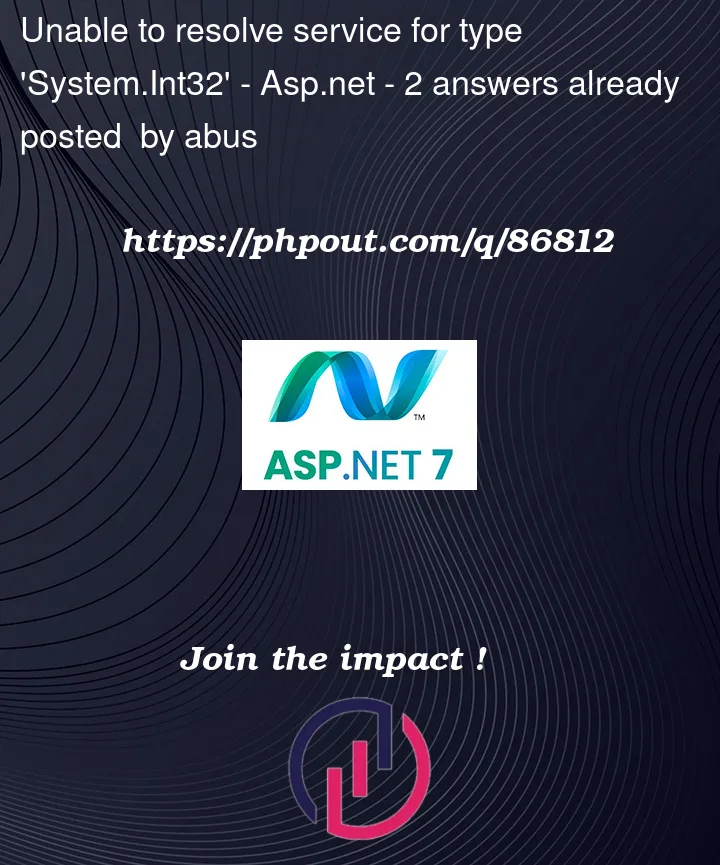Is it possible to have interfaces with other paramaters together like here below?
I do this because I have private setters and have one constructor.
planning constructor (Logic)
public Planning(
IPlanningDAL planningDAL,
IPlanningParticipantDAL planningParticipantDAL,
ICategoryCollectionDAL categoryCollectionDAL,
ITaskCollectionDAL taskCollectionDAL,
ITaskDAL taskDAL,
IParticipantDAL participantDAL,
ICategoryDAL categoryDAL,
int id,
string name,
DateTime startDate,
DateTime? endDate,
Participant leader)
{
this.planningDAL = planningDAL;
this.planningParticipantDAL = planningParticipantDAL;
this.categoryCollectionDAL = categoryCollectionDAL;
this.taskCollectionDAL = taskCollectionDAL;
this.taskDAL = taskDAL;
this.participantDAL = participantDAL;
this.categoryDAL = categoryDAL;
Id = id;
Name = name;
StartDate = startDate;
EndDate = endDate;
Leader = leader;
}
ASP.NET Core MVC program
builder.Services.AddScoped<Planning>();
error
System.AggregateException: ‘Some services are not able to be constructed (Error while validating the service descriptor ‘ServiceType: Logic.Models.Planning Lifetime: Scoped ImplementationType: Logic.Models.Planning’: Unable to resolve service for type ‘System.Int32’ while attempting to activate ‘Logic.Models.Planning’.)




2
Answers
A question similar to your question asked before.
I think the following link can help you .
Error while validating the service descriptor 'ServiceType: INewsRepository Lifetime: Singleton ImplementationType: NewsRepository':
From the context of the question I distilled the following:
Planningrepresents an entity and considering the number of design-time dependencies (such as yourIPlanningDAL) the class has, it seems you are trying to apply some sort of Domain-Driven Design. An entity is an object that is primarily defined by its identity (e.g. theint Idin your case).int Id,string Name,DateTime StartDate, DateTime? EndDate, andParticipant Leader` seem values define the entity’s current state, rather than configuration values that stay unchanged for all entities in the system and while the system is running.The remainder of my answer rest on the previous assumptions.
Object Composition, in the context of Dependency Injection, is meant to compose application components like a behavior-centric
SqlPlanningDAL. It’s not meant for the construction of data-centric object like entities. The use of DI Containers exaggerate this, because it becomes hard to create data-centric objects with design-time dependencies when using a DI Container such as the built-in ASP.NET Core DI Container Microsoft.Extensions.DependencyInjection (MS.DI). This means that addingPlanningto the Container such as you are doing here is not a good idea:The reason for this is that although the container can supply the configured design-time dependencies to the class, it has no way of knowing what runtime values it should provide. And how could it? These values will change for each entity and are typically loaded from some data source.
This means that any time the construction of an object requires both runtime data and design-time dependencies (as with your
Planningentity), object composition gets complicated, which is why I consider injecting runtime data into components a code DI smell.A way to solve this is by moving the creation of
Planningto a repository of some sort (likely yourPlanningDAL):Although this could certainly technically work, this model will —in the long run— likely become a maintenance nightmare. This is because in an evolving domain, new domain logic will be added regularly, which will force changes to both the
PlanningDal(i.e. your repository) and thePlanningentity.A more commonly-used —and more-maintainable— model is to move
Planning‘s design-time dependencies to specific methods onPlanningthat require their use. So instead of applying them using Constructor Injection, you use Method Injection instead. This means that only the entity’s data values will be applied to the constructor:This does mean, however, that those dependencies must be supplied by consumers of these domain methods. For instance: